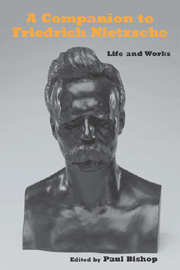Book contents
- Frontmatter
- Contents
- Acknowledgments
- A Note on Editions and Abbreviations
- Introduction
- Link to Nietzsche's Early Writings
- Link to The Birth of Tragedy
- Link to Untimely Meditations
- Link to Human, All Too Human
- Link to Daybreak
- Link to The Gay Science
- Link to Zarathustra
- Link to Beyond Good and Evil
- Link to On the Genealogy of Morals
- Link to The Case of Wagner and Nietzsche contra Wagner
- Link to Twilight of the Idols, The Anti-Christ, and Ecce Homo
- Link to the Nachlass
- Conclusion
- Notes on the Contributors
- Index
Link to the Nachlass
Published online by Cambridge University Press: 05 February 2013
- Frontmatter
- Contents
- Acknowledgments
- A Note on Editions and Abbreviations
- Introduction
- Link to Nietzsche's Early Writings
- Link to The Birth of Tragedy
- Link to Untimely Meditations
- Link to Human, All Too Human
- Link to Daybreak
- Link to The Gay Science
- Link to Zarathustra
- Link to Beyond Good and Evil
- Link to On the Genealogy of Morals
- Link to The Case of Wagner and Nietzsche contra Wagner
- Link to Twilight of the Idols, The Anti-Christ, and Ecce Homo
- Link to the Nachlass
- Conclusion
- Notes on the Contributors
- Index
Summary
When he received a Wahnsinnszettel from Nietzsche, Strindberg replied immediately (in Latin) with a quotation from Horace:
Rectus vives, Licini, neque altum semper urgendo neque, dum procellas cautus horrescis, nimium premendo litus iniquum.
[You would lead a better life, Licinius, if you neither shaped your life constantly towards the open sea, nor, shivering tremulously in the face of the storm, held too closely to the treacherous coast.]
Much of Nietzsche's life had been spent, in metaphorical terms, doing precisely this: he had looked into the horizon of the infinite (GS §124), lived dangerously, built his cities on the shores of Vesuvius, and sent his ships into uncharted seas (GS §283), urging philosophers to “embark!” (GS §289) and gazing into the monstrous eye of infinity (“Toward New Seas” [“Nach neuen Meeren”]; KSA 5, 649), just as Zarathustra gazed out upon open seas from the midst of superfluity, no longer saying “God,” but saying “Superman” (Z II 2; KSA 4, 109). And in respect of the Revaluation of All Values (Umwerthung aller Werthe) Nietzsche described his future work as “the distant sound of thunder in the mountains” (mit einem fernen Donner im Gebirge; KSB 8, 453).
Following his collapse in Turin in January 1889, Nietzsche sent a note to Cosima Wagner, which said, simply: “Ariadne, I love you. — Dionysos” (Ariadne, ich liebe Dich. Dionysos; W 3, 1350). When he was in the psychiatric clinic in Jena, he is recorded as saying: “My wife, Cosima Wagner, has brought me here” (Meine Frau Cosima Wagner hat mich hierher gebracht).
- Type
- Chapter
- Information
- A Companion to Friedrich NietzscheLife and Works, pp. 399 - 404Publisher: Boydell & BrewerPrint publication year: 2012

